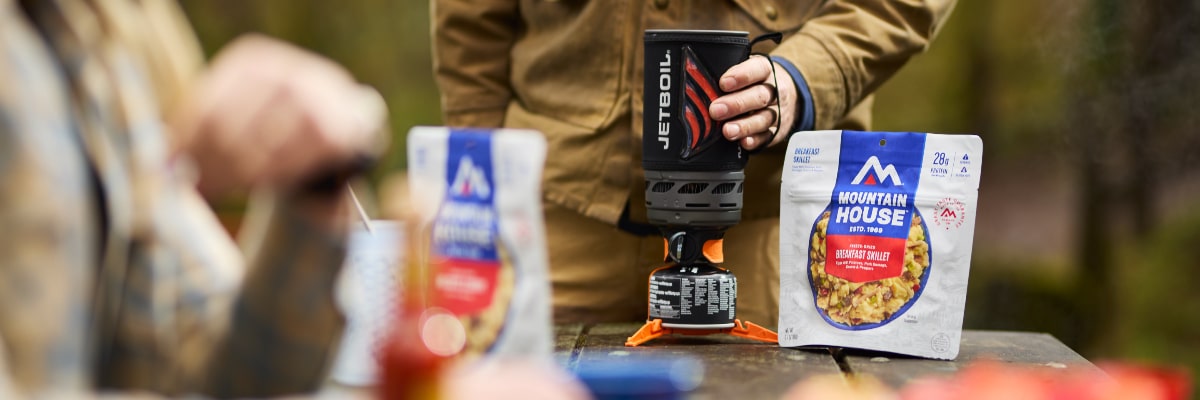Inspired for an Adventure? Check out Beef Stroganoff - Pouch and Beef Stew - Pouch
Free Ground Shipping On All Orders
Over 2,100 Reviews
Add description, images, menus and links to your mega menu
A column with no settings can be used as a spacer
Link to your collections, sales and even external links
Add up to five columns
Add description, images, menus and links to your mega menu
A column with no settings can be used as a spacer
Link to your collections, sales and even external links
Add up to five columns


Here at Mountain House, we’ve been producing top-quality freeze-dried food since the 1960s, feeding generations of hikers, campers, hunters, soldiers, anglers, explorers, and even astronauts—not to mention folks experiencing natural disasters and other emergency situations who need reliable meal options.

But is freeze-dried food, so widespread and popular among outdoor enthusiasts, military personnel, and emergency preppers alike, actually healthy? Does it provide the body with the necessary nutrients?
The overall answer to this question is yes, freeze-dried food can make for a nutritious meal option. Healthy is a somewhat relative term, however, because people are on different health journeys and may have different needs when it comes to food. We will explore how freeze-drying preserves nearly all nutrients in food, how this compares to other food preservation methods, and the benefits of freeze-dried products.
Understanding the Freeze-Drying Process
If we’re going to talk about the relative healthiness of freeze-dried food, it’s best to start by answering the question, what exactly is freeze-drying?
Freeze-drying—also known by the more technical term lyophilization—is one category of food dehydration that involves quickly freezing a food item, placing it in a vacuum, and then applying a low heat. That exposure to heat under vacuum pressure causes the ice crystals within the food—its frozen moisture content—to vaporize into gaseous form. That direct transformation of ice crystals into water vapor without a liquid melt phase in between is known as sublimation.
There are a couple of very important results from this freeze-drying method. First, it’s very efficient at sublimating ice crystals. As much as 98 or 99% of the natural moisture content in a given food can be removed through freeze-drying. It’s that natural moisture content that’s responsible for a lot of spoilage issues with food, including the growth of potentially harmful microbes. Getting almost all of the moisture out of the food makes it safely shelf-stable.
Second, the fact that the moisture is rapidly removed through sublimation, turning the ice crystals into water vapor without involving an intervening liquid stage—and the fact that the food is not subjected to high, degrading heat as part of preparing it for storage—preserves the pore structure of the food. And that, in turn, means that the nutritional value of the food—not to mention its flavor, texture, odor, and color—is mostly all preserved.
Simply adding the prescribed amount of water to freeze-dried food—that is, rehydrating it—reconstitutes it to its pre-frozen form, complete with all of those original attributes just about wholly intact.
For more nuts and bolts on this type of preservation, check out our article that explains the freeze-drying process and our quick, to-the-point video overview below.
Nutritional Value of Freeze-Dried Foods
From vitamins to antioxidants to fiber to enzymes, 90% or more of the nutritional makeup of freeze-dried food is preserved through the preservation process because of the physics of sublimation and the absence of high heat treatment.
It follows, then, that freeze-dried food is roughly as nutritionally rich as its original, non-freeze-dried form, with only a very small loss of nutrients during the preservation process. This then means that if you’ve freeze-dried healthy, nutritionally rich, and balanced food, you’re going to have a nutritionally rich and balanced end product with a long shelf life. If the food you freeze-dry isn’t nutritionally rich, to begin with, you’re not adding nutrients by freeze-drying.
Here at Mountain House, all of our recipes start with high-quality, fresh ingredients. We list every ingredient we use right on our label so customers know if a meal fits their nutritional needs.
Comparison With Other Preservation Methods
Many other methods of dehydrating or preserving foods, such as air-drying or heat-drying, alter or degrade the structure of the food in the process. This, very roughly speaking, explains a lot of the changes to color, flavor, and texture you may experience with traditionally dehydrated meals or ingredients. As we’ve mentioned, freeze-drying can preserve well north of 90 percent of the food’s original attributes—nutritional content included. So rehydrated, freeze-dried fare often looks, tastes, and smells much more like the “real thing.”
Also, freeze-drying is more efficient at removing moisture than many alternative and commonly available food-dehydration methods. Standard dehydrated food typically gets rid of 80 to 95% moisture content, compared to (again) as much as 99% when it comes to freeze-drying.
Beyond the nutrient loss or alteration of natural inherent flavor and texture with standard dehydration, sugars, and other additives may be incorporated into certain dehydrated foods as well. All of that combines to typically make for a less-healthy option than the freeze-dried alternative.
Benefits & Drawbacks of Freeze-Dried Food
Let’s zero in on the chief benefits and drawbacks of freeze-dried food.
Benefits
We’ve already discussed how well freeze-drying preserves the original nutrition, flavor, mouthfeel, aroma, and color of a food item as compared to many other methods of dehydration. However, the retention of those qualities is only one of the benefits of freeze-dried foods.
Lightweight & Long Lasting
Because it removes so much of the water content of food, freeze-drying also gives you a wonderfully lightweight meal—absolutely ideal, needless to say, for backpacking, camping, hunting, angling, and other in-the-field activities. Not only that, but it translates to just about unbeatable extended shelf life. Here at Mountain House, we’re proud to offer an industry-leading 30-year shelf life for our freeze-dried meals—and that shelf life isn’t only based on the safety of the food but on the quality of the flavor. Our premium packaging also plays a crucial role in this, protecting the meals from moisture, light, and air, ensuring that the taste remains just as delicious decades later.
Easy, High-Quality Meals
The convenience of freeze-dried food products, which includes how quickly they can be prepared (within minutes!) with minimal ingredients (the just-add-water magic!), makes them a great alternative to other “quick,” but often unhealthy, grub such as fast food, candy, and many low-quality frozen foods. High-quality freeze-dried fruits, soups, stews, and other products give you an excellent and balanced energy boost for hiking, paddling, climbing, and other outdoor activities (which are, of course, their own gateways to a healthier lifestyle!).

It’s worth noting, too, that just about any type of food can be effectively prepared with the freeze-drying process. The sky’s pretty much the limit for a commercial facility such as ours at Mountain House which means you’ve got many different freeze-dried food options to choose from (with various options specific to dietary needs). Variety’s the spice of life, not least out on the trail (or when it comes to a crunched weeknight dinner), so the wide array of freeze-dried eats has to be counted as another real benefit!
Drawbacks
The specific drawbacks of freeze-dried food aren’t many, so long as you’re selecting healthy options to begin with.
Some Nutrient Loss
Certainly, there can be some loss of nutrients in the freeze-drying process, even if it’s generally much less than what results from traditional food-dehydration processes.
Requires Proper Storage
It’s also worth emphasizing that freeze-dried food needs to be properly stored, especially if it’s being stored long-term. Keeping it in hot conditions for an extended period can affect the shelf life. Store Mountain House meals in dry, sanitary conditions, avoiding prolonged exposure to extreme temperatures and environments that could damage the packaging, such as punctures or dents. To maximize shelf life, keep the food unopened and avoid prolonged exposure to temperatures above 75°F (24°C).
So, Is Freeze-Dried Food Healthy?
Is freeze-dried food good for you? Absolutely—if it’s prepared from healthy ingredients to begin with, that is!
And with Mountain House, you can expect the highest-quality kind of freeze-dried food, based on a proprietary freeze-drying method we’ve honed over more than a half-century. Explore our entire collection of delicious, just-add-water freeze-dried meals today!

MRE vs Freeze-Dried Food

What Ingredients Are in Mountain House Freeze-Dried Meals?


Stay Hungry for Adventure
Sign Up for Delicious Outdoor Meals & Exclusive Offers!
By clicking ‘Join Now’, I agree to the Terms of Service and Privacy Policy.


Join the adventure
©2025 Mountain House — All Rights Reserved.
Your Cart is Empty
Continue ShoppingYour Cart
Subtotal
$0.00
EXPRESS PAYMENT METHODS AVAILABLE IN CHECKOUT
Taxes and Shipping Calculated at Checkout
Your ExpertVoice deal.
$[Deal Price]
$[Original Price]
Discount applied at checkout.
On sale now — lower than your ExpertVoice discount.
Not eligible for ExpertVoice discount.














